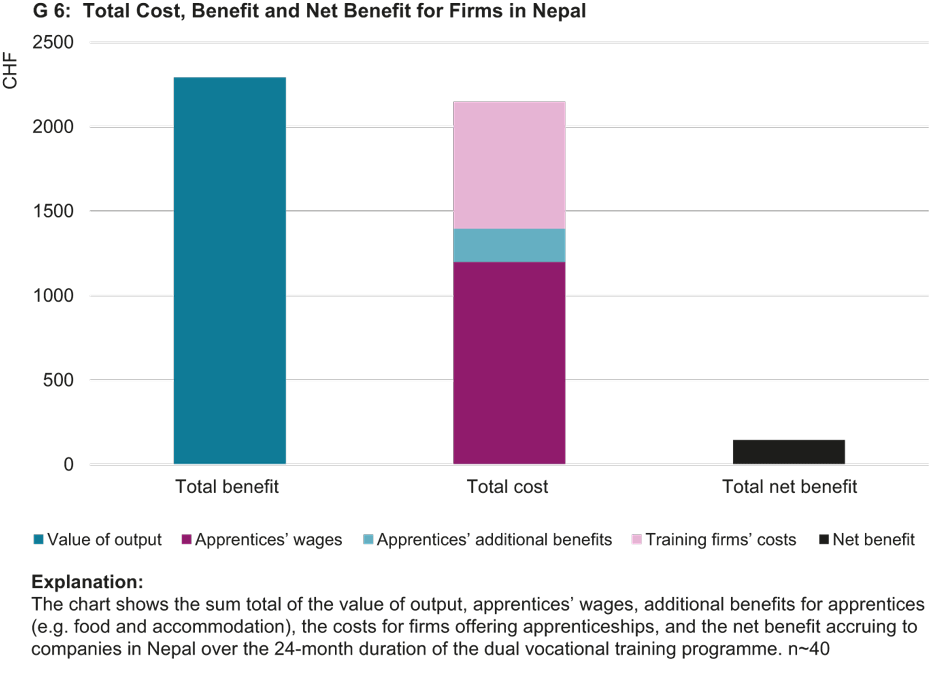Is dual vocational training worthwhile for companies in Nepal?
- KOF Bulletin
- Education
Apprentices’ wages, additional benefits for apprentices, and the costs for firms offering apprenticeships: the authors of a new KOF Working Paper have investigated whether these dual vocational training costs are offset by the value produced by apprentices during their training. The findings of a pilot project in Nepal show that companies achieve a modest net benefit when they offer apprenticeships.

In autumn 2018 the Swiss Agency for Development and Cooperation (SDC) launched a pilot project to introduce dual vocational training in Nepal. This is a formal vocational training programme in higher secondary education that lasts 24 months. For most of these two years, students spend five days a week at a company and one day a week at school.
The introduction of a dual vocational training system poses a challenge for all those involved. This is because, in addition to state actors and schools, companies must also be persuaded to offer apprenticeships for dual vocational training. This is particularly difficult if the companies concerned do not yet have any experience of the costs and benefits that will accrue to them. For this reason the authors have simplified the calculation methods used in Switzerland to determine the costs and benefits of vocational training for firms (see, for example, Dionisius et al., 2008; Mühlemann and Wolter, 2014). This allows an early estimate of the net benefit expected based on a survey of about 40 companies.
Training employers achieve modest net benefit
The calculation method is based on the assumption that the productivity of apprentices at the beginning of their dual vocational training approximates to the wage of an untrained employee. Subsequently, the apprentices’ productivity rises linearly until it reaches that of a trained employee. According to the companies surveyed, it takes 22 months for apprentices to achieve full productivity. It should also be remembered that, during the dual vocational training period, apprentices spend 20 months at the company and one day a week at school. Chart 6 shows that the resulting value of the output generated by apprentices during their entire apprenticeship is around 2,300 Swiss francs. This is roughly equivalent to the value of twelve months' work done by a trained employee in Nepal.
The value of output generated by apprentices must be compared with the costs incurred by firms. The most important component here is apprentices’ wages, which account for 56 per cent of the total costs. Additional benefits for apprentices, such as allowances in the form of food and accommodation, account for 9 per cent of these costs. In addition, trained employees spend on average around nine hours a week training apprentices. This accounts for 35 per cent of the total costs.
A comparison of benefit and cost totals shows that on average companies achieve a modest net benefit of around 145 Swiss francs, which almost equates to the monthly wage of a trained employee.
Vocational training period and apprentices’ wages play a key role
The 24-month duration of the vocational training programme is a decisive factor in ensuring that firms achieve a net benefit. Although apprentices’ productivity is still comparatively low at the beginning of their dual vocational training, it increases over the course of the apprenticeship. At the same time, the cost of employees training apprentices decreases. The duration of training is therefore long enough for firms to recoup the investment they make at the start of the apprenticeship.
The level of apprentices’ wages is also important. In Nepal the legally prescribed minimum wage paid to apprentices is 28 Swiss francs per month, which is about 14 per cent of a trained worker’s wage. The actual apprentice's wage at the beginning of training at the companies investigated is on average 45 francs, which is thus above the prescribed level. This shows that the legally prescribed minimum wage is low enough to enable companies to offer apprenticeships that are profitable for them.
Nepalese companies have not yet been able to gain experience of the costs and benefits of dual vocational training. This analysis can therefore help to persuade companies that offering apprenticeships is financially worthwhile. However, the findings presented here are based on a relatively small number of observations, and the projection method used is based on simplifying assumptions. It is therefore important to verify these findings in future studies.
1) The authors would like to thank the Swiss Agency for Development and Cooperation (SDC), the Swiss National Science Foundation and the SDC Nepal, which financed parts of this study.
References
Bolli, T., J. Kemper, M. N. Parajuli, U. Renold, and B. K. Thapa (2020): Projection of Net Benefits for Companies in the Dual Vet-Apprenticeship Programme in Nepal, KOF Working Papers, 145, https://www.research-collection.ethz.ch/handle/20.500.11850/388868.
Dionisius, R., S. Muehlemann, H. Pfeifer, G. Walden, F. Wenzelmann, and S. C. Wolter (2008): Cost and benefit of apprenticeship training-A comparison of Germany and Switzerland.
Muehlemann, S. and S. C. Wolter (2014): Return on investment of apprenticeship systems for enterprises: Evidence from cost-benefit analyses. IZA Journal of Labor Policy, 3(1), 25.
Contact
Professorship for Education Systems
Switzerland

